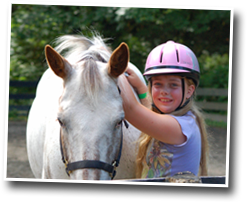Haven of Hope Clinic Guidelines
How to approach a new horse
Approach a horse from the shoulder, never directly in front. Move smoothly with confidence and quietly. Discuss spookiness and house flight instincts when frightened.

Horse blind spots
Blind spots are directly behind the tail, under the chin, and about three feet directly in front of the face. Never take your eyes off a nervous horse.
Picking up and handling hooves (feet) safely
Always let the horse know your intentions so it can balance itself. You may run your hand down the leg before asking for a hoof. When handling the hind hooves always stand at the horse’s flank with our knees facing out to the side away from the hoof. Bring the hoof forward under the belly first, then take it back behind the horse and rest the hoof on your knees. This method will save your knees if a hours “cow kicks” at you or kicks out behind.
How to walk behind a horse
Remain close so a kick would have less impact. Never walk under the neck while a horse is tied.
Leading a horse safely
Stay a few feet in front of the horse’s head. Hold the rope properly, not coiled around your hand
Tying
Learn how to tie the quick release knots. Tie horses at eye level and the rope should be no longer than your arm.
Grooming
- Begin with a metal curry comb for thick coats or heavy mud and grime.
- Start behind the ear and move across and down the body. Avoid the lower legs.
- Use a rubber curry to further loosen hair and dust in the same manner.
- Use dandy brush to get dust and hair off. Pay attention to lower legs, under the belly, and between the front legs.
- Finish with a soft brush to polish and brush bony areas like the face and joints.
- Pick hooves and brush off the outside of hooves with a hoof brush.
- Use a detangler for the manes and tails. Comb the mane and tail when they are dry.
Saddling and Bridling
- Begin by checking the pad for any debris. Place the pad squarely on the horse’s back just before the top of the withers. Place the pad farther forward than intended so it can slide back and smooth hair. Always chuck the saddle and bridle for signs of wear and weak spots before tacking up.
- Prepare the saddle by placing the left stirrup and cinches over the seat. Hold the saddle with the left hand on the pommel and the right hand on the cantle, or the back of the skirt.
- Stand by the shoulder facing the rear of the horse. Swing the saddle over the horse’s back in one quick motion and place (not slam) the saddle squarely in the center of the pad. Slide the saddle and pad back a few inches so the saddle sits comfortably on the back. The cinch should hang just behind the horse’s elbow.
- Walk around behind the horse and let down the cinches and the stirrup. Take care to keep everything straight with no twists.
- Carefully reach under the belly of the horse and grasp the cinch. Cinch the horse properly, leaving a hand space between the horse and cinch. The rear cinch should also fit snugly.
- Two ways to cinch are buckle and knot.
- Discuss the fit of the bridle and demonstrate the way to hold one.
- Hold the crown piece in the right hand and the bit and chain in the left hand. Place the right arm between the horse’s ears and with the left hand introduce the bit. Once bitted slide the crown piece over the horse’s ears without bunching them up. Adjust the brow band, throat latch, and arrange the reins.

